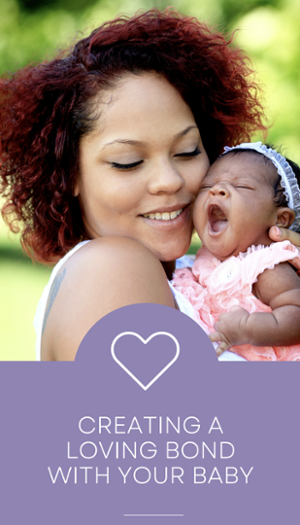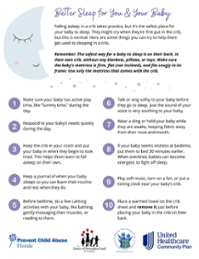It's a New Day in Public Health.
The Florida Department of Health works to protect, promote, and improve the health of all people in Florida through integrated state, county, and community efforts.
Safe Sleeping Environment
Contact the Maternal and Child Health Section
- 850-245-4465
-
Fax
850-245-4047
Learning the Sleep Basics
Always place your baby on their back to sleep every time you lay your baby to sleep.
- Make sure baby sleeps only on a firm sleep surface, such as a safety approved crib mattress, bassinet, or portable crib.
- Do not cover your baby with a loose blanket. Instead, dress your baby in a sleeper appropriate for the room temperature.
- Do not place stuffed animals, crib bumpers, blankets, quilts, baby positioners or any other soft items in the crib.
- Never place your baby to sleep on an adult bed, recliner, sofa, air mattress, bean bag chair, pillow, quilt, or any other soft surface.
- Do not sleep with your baby.
- Do not fall asleep with your baby in your bed or in any other place while you are holding your baby (such as on a sofa or recliner).
Bed-sharing is Dangerous
When babies bed share, they are at higher risk for suffocation and sudden infant death syndrome (SIDS).
Suffocation occurs when a baby is not able to breathe due to lying in a position where something is blocking oxygen from getting to the baby. This can occur from an adult or child rolling over onto the baby. It can also occur if something soft such a pillow, blanket, sheet or the mattress itself blocks the baby’s airway.
Room-Sharing
If you want to keep your baby close to you, try room-sharing. Place the bassinet or crib by your bed. This way, your baby can sleep safely in their own safe sleep area and you can sleep better knowing your baby is near.
Reducing the Risk of SIDS
In addition to sleeping on his/her back, in his/her own crib, and in a safe sleep environment, studies have found that there are additional ways reduce your baby’s risk of SIDS:
- Breastfeeding
- Not smoking, drinking alcohol, or using drugs during pregnancy
- Not allowing anyone to smoke around your baby
- Keeping your baby’s routine pediatrician appointments
- Offering a pacifier at nap and bedtime. If you are breastfeeding, wait until breastfeeding is going well before offering a pacifier. This is usually around one month.
- Making sure your baby does not get overheated. If the room feels comfortable for you, it's comfortable for your baby.
- Talking to everyone who cares for your baby about following your baby’s safe sleep practices and other ways to reduce your baby’s risk of SIDS.
Additional Infant Safe Sleep Information

Community Engagement
Community organizations including day care centers, pregnancy resource centers, and any organization that serves women and men with babies can help to spread the word about safe sleep.
The following are free bulk educational materials your organization can order to help educate everyone on safe sleep.




Connect with DOH